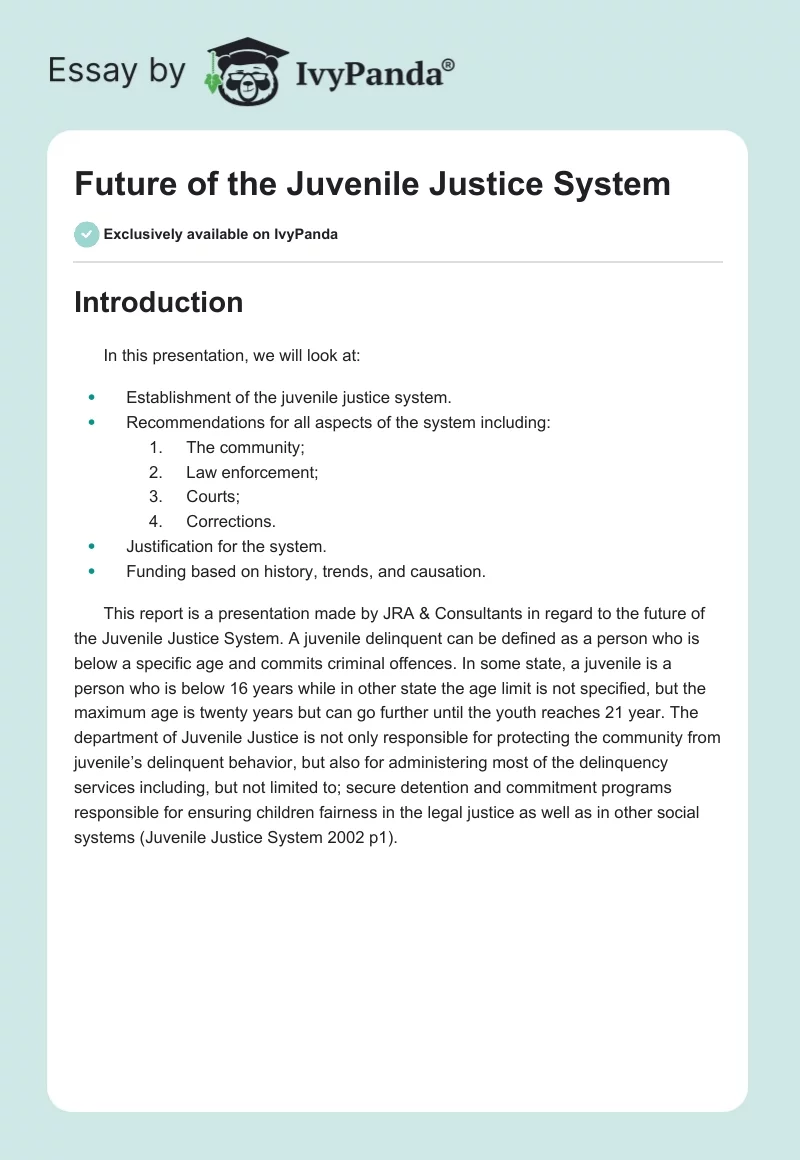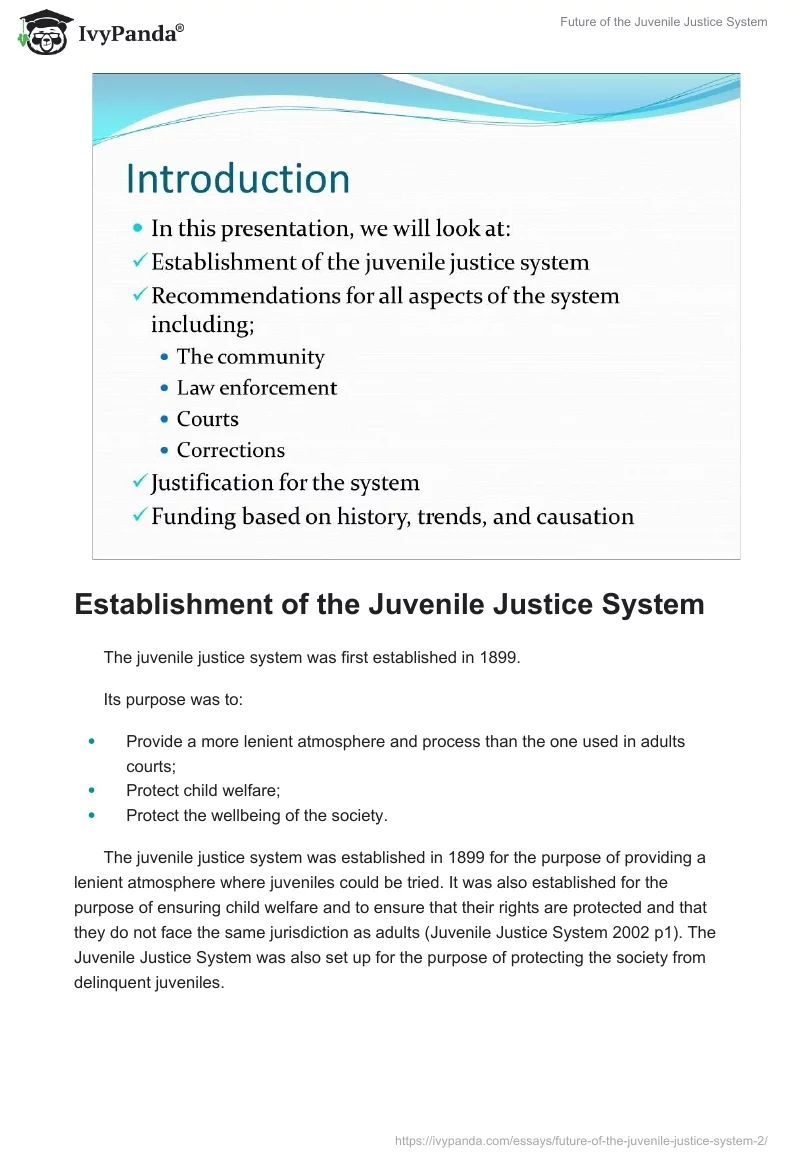Introduction
In this presentation, we will look at:
- Establishment of the juvenile justice system.
- Recommendations for all aspects of the system including:
- The community;
- Law enforcement;
- Courts;
- Corrections.
- Justification for the system.
- Funding based on history, trends, and causation.
This report is a presentation made by JRA & Consultants in regard to the future of the Juvenile Justice System. A juvenile delinquent can be defined as a person who is below a specific age and commits criminal offences. In some state, a juvenile is a person who is below 16 years while in other state the age limit is not specified, but the maximum age is twenty years but can go further until the youth reaches 21 year. The department of Juvenile Justice is not only responsible for protecting the community from juvenile’s delinquent behavior, but also for administering most of the delinquency services including, but not limited to; secure detention and commitment programs responsible for ensuring children fairness in the legal justice as well as in other social systems (Juvenile Justice System 2002 p1).
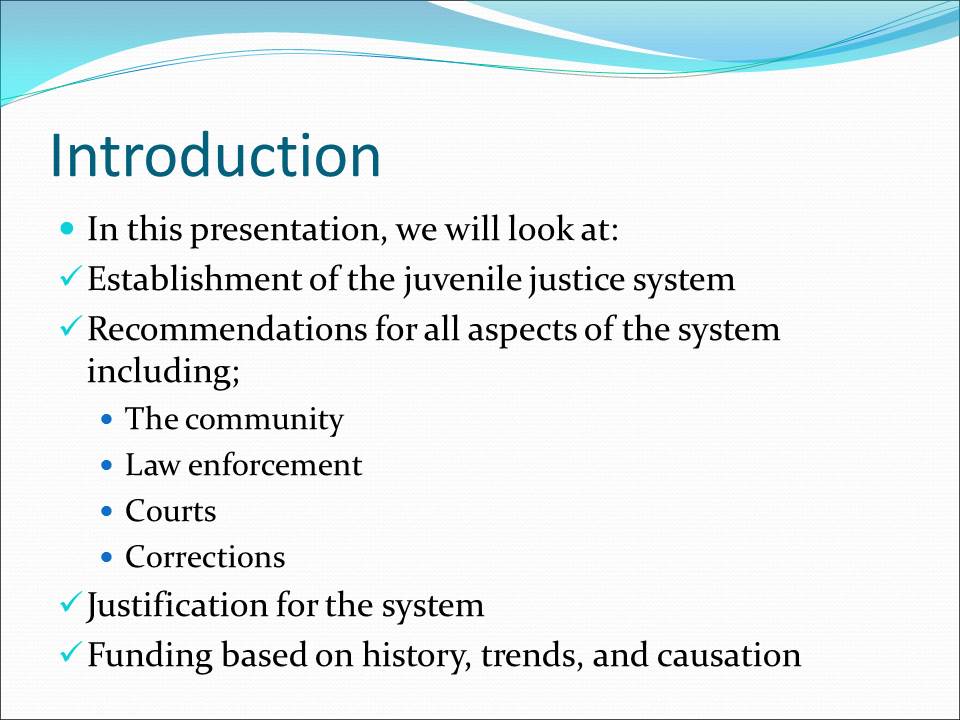
Establishment of the Juvenile Justice System
The juvenile justice system was first established in 1899.
Its purpose was to:
- Provide a more lenient atmosphere and process than the one used in adults courts;
- Protect child welfare;
- Protect the wellbeing of the society.
The juvenile justice system was established in 1899 for the purpose of providing a lenient atmosphere where juveniles could be tried. It was also established for the purpose of ensuring child welfare and to ensure that their rights are protected and that they do not face the same jurisdiction as adults (Juvenile Justice System 2002 p1). The Juvenile Justice System was also set up for the purpose of protecting the society from delinquent juveniles.
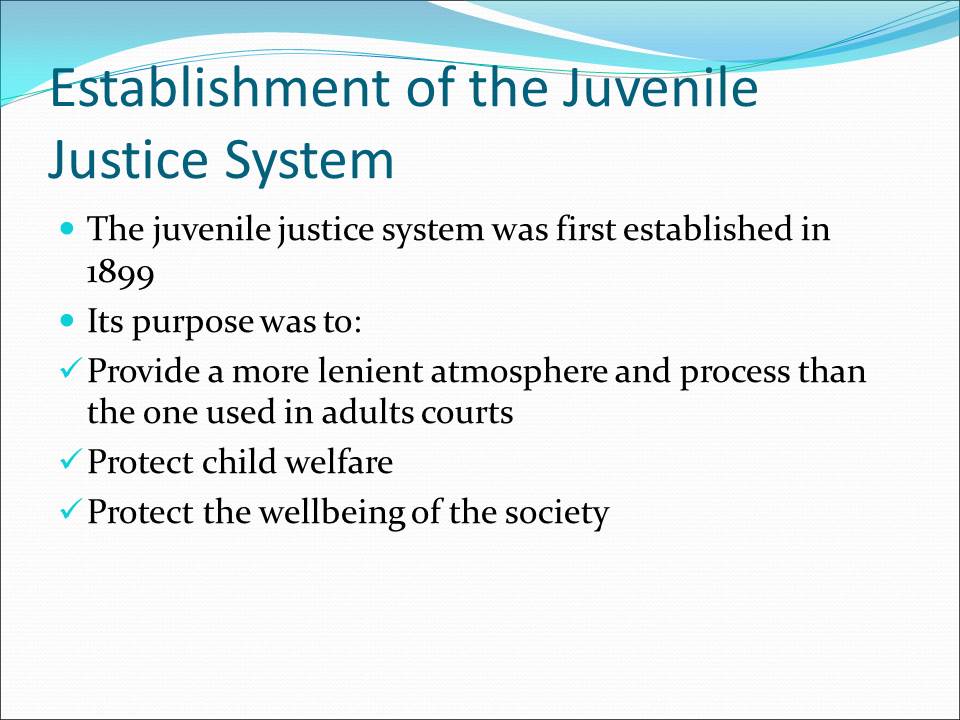
Recommendation for the community
- All victims should be given certain rights;
- They should be allowed to submit a statement in a delinquency hearing;
- The judge should be the ones to decide whether to use the victim’s statement or not;
- If its is proved that the victim was hurt by the offenders act, the juvenile is required to compensate the victim.
All victims of juvenile lawbreakers should be given certain rights. They should be allowed to submit a statement in a delinquency hearing if the offense in question meets a given decisive factor. The judge or a district attorney may decide to use the victim’s statement or rely on his own jurisdiction over the matter. If it is proved beyond any reasonable doubt that the victim was actually hurt by the offender’s acts, the juvenile is required by law to pay compensation to the victim. Further, the victims are warned against a repeat of the same felony if the offender is set free (Hess, 2009 p10). This shows that, the juvenile justice system is not only concerned about the lives of the young offenders but also that of the entire society.
A juvenile is liable for detention for the purpose of self protection, protection of other youths, or the society at large.
There are two forms of detention:
- secure;
- non-secure:
- In-house detention;
- electronic monitoring.
A juvenile is liable for detention if the administrators feel that, there is need to protect the person in question his property or that of other youths, the youth may escape, or there is no adequate supervision for the youth and that the youth is not provided with proper care. Regardless of the reason for detention, the hearings must be heard within seventy two hours. There are mainly two forms of detention; secure, and non-secure. Secure Detention is normally used as a form of approval for probation infringements. Non-secure detention is offered in a regional youth detention center and it is not applicable to staff. Under this program two services are offered, namely In-Home supervision and electronic monitoring. In-House supervision is a form of detention where youths are allowed to stay at their home and go to the court only when it is necessary (Hess, 2009 p12). On the other hand, electronic monitoring is the use of technology to monitor juveniles leaving in the community. It is used as a second option to juvenile offenders in place of detention.

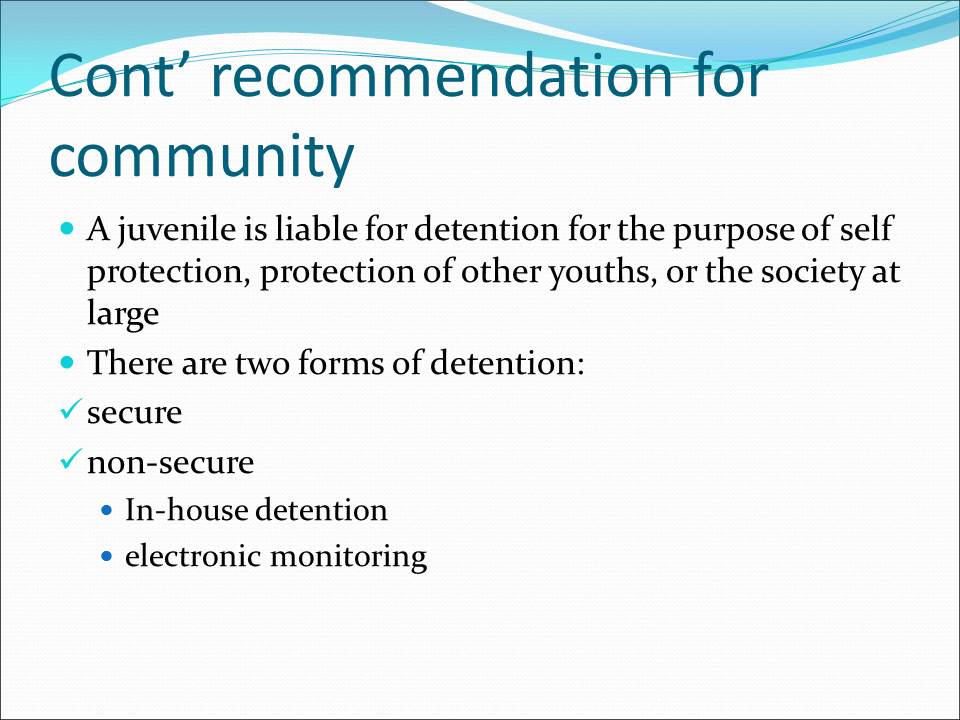
Recommendations for law enforcement
In addressing this section, we will first look at the changes that has taken place in the Juvenile Justice System. These are:
- Increase in juvenile crimes due to the proliferation of drugs and guns and other changing social conditions leading to tougher laws.
- Increased number of juvenile transfers to criminal courts.
- This changes has made the juvenile courts to behave more like criminal courts.
According to JRA & Consultants, the juvenile court system has changed significantly since its original formation. While court decisions have granted minors more rights, the proliferation of drugs and guns, as well as other changing social conditions, has created a rise in juvenile crime that has in turn led to tougher laws and increased the number of juvenile transfers to criminal courts. Both factors have caused the juvenile court system to behave more and more like criminal courts over the years, until now the system is almost indistinguishable from its adult counterpart (Mortimer & Larson, 2002 p118). Whether one favors emphasizing rehabilitation efforts for juvenile offenders or taking the route of punishing those who break the law, both sides have expressed the opinion that the current system needs to be changed.
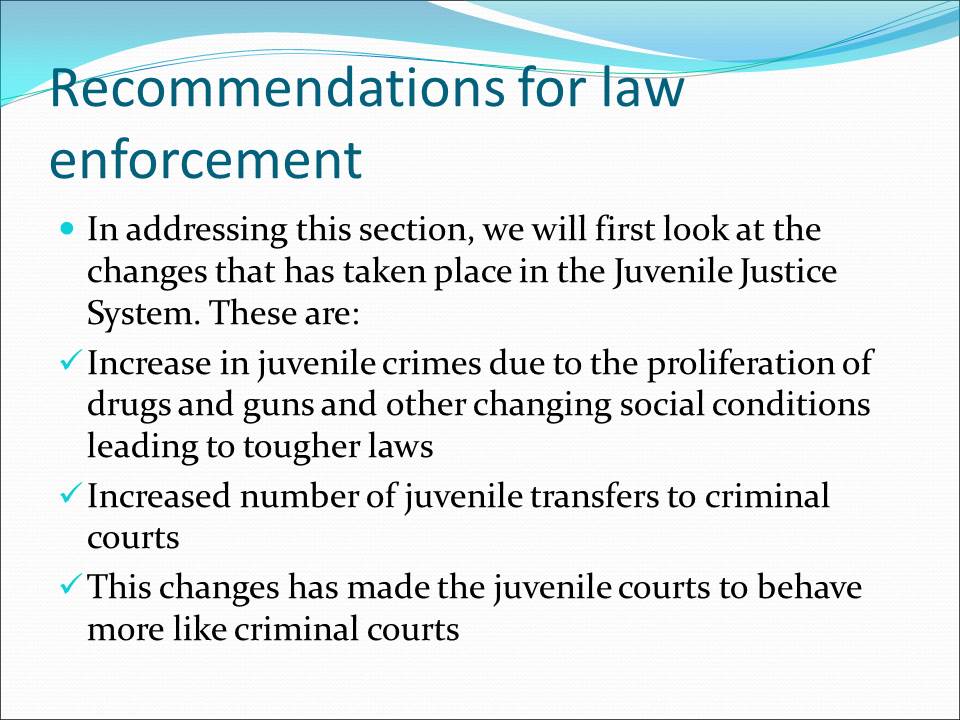
Problem of proceedings
- Conditions of incarceration;
- The question of defending children from damage and maintaining secure conditions for them while in the state’s care and detention;
- The predicament of huge costs linked with proceedings;
- The rising cost of building and operating correctional facilities.
The problem of proceedings is apt to augment in the future as correctional facilities face population increases, crowding, and poor conditions. Proceedings concerning juvenile inmates have also dealt with the conditions of incarceration, and courts have ruled that the state of affairs in some juvenile facilities do comprise brutal and strange punishment. Another lawful issue is the question of defending children from damage and maintaining secure conditions for them while in the state’s care and detention. Centralized courts have ruled that states do have a compulsion to take sensible steps to protect children in their care from physical attacks by other inmates, and are legally responsible for non-accidental injuries sustained as a result of negligence and inaction. States are faced with the predicament of gigantic costs linked with proceedings, and the rising cost of building and operating correctional facilities (Juvenile Justice System 2002 p1).
- Problem of overcrowding;
- Pressure of workers to control the diverse population of lawbreakers;
- Under qualified- and under trained workers;
- Need for skilled Attorneys.
Proceedings are directly linked to crammed full facilities that augment the anxiety levels of inhabitants and workers who are under pressure to maintain control of a growing and diverse population of lawbreakers. Trying to maintain sufficient staffing levels and lessen personnel costs over and over again results in under-qualified and under trained workers who may add to the risk of offensive behavior toward a diverse rising institutional population. Many juvenile court procedures are official in nature, thus necessitating the intrusion of skilled attorneys. Legal procedures are so deep-rooted that legal advice will persist to be essential for supporting the rights of indicted juvenile offenders, as well as encouragement on behalf of the state. Even though the staffs of many juvenile support organizations are composed of professionals in the field who know the dealings of juvenile courts, it is the attorneys they hold on to who will put up with blame for most proceedings (Hess, 2009 p10). This makes sensible sense from the viewpoint of support organizations, because prosecutor’s offices will definitely maintain their juvenile trial divisions.
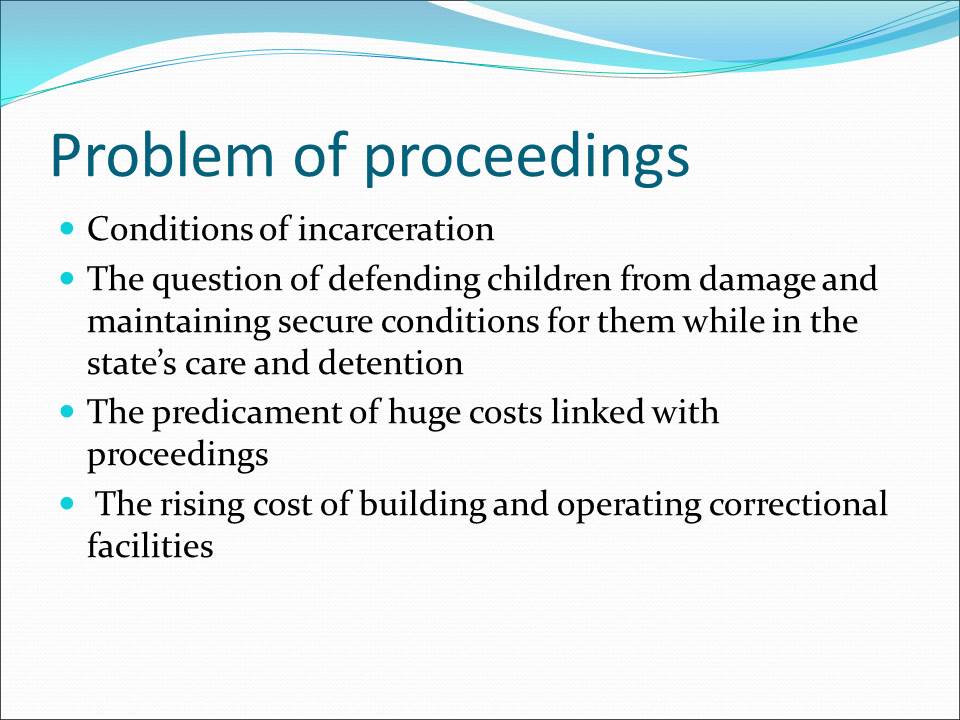
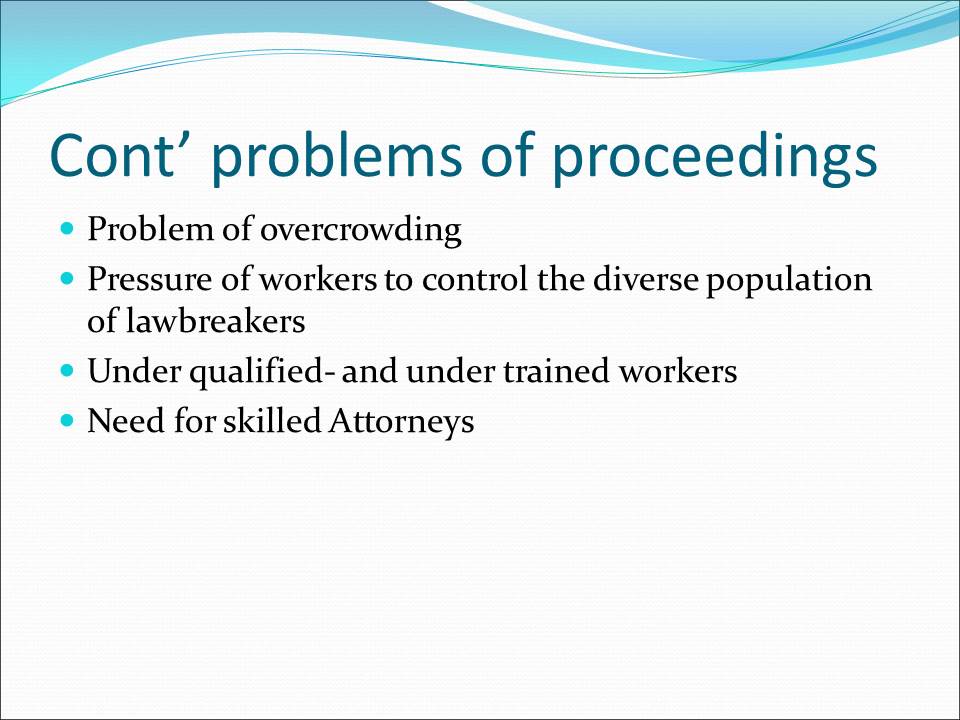
The future of the law enforcement
Many changes have to take place in the near future if the juvenile justice system is to fulfill its mission. This includes:
- Re-definition of juvenile and age of responsibility;
- Revision of the juvenile codes;
- Judicial and legislative changes.
According to JRA & Consultants, the juvenile justice system must face a number of issues and questions, including the future of the juvenile court, the jurisdiction definition of juvenile and the age of responsibility. Most states have revised their juvenile codes and redefined the purpose of the juvenile court, de-emphasizing rehabilitation and placing more importance on public protection and safety. Judicial and legislative changes have criminalized the juvenile court (Elrod & Ryder, 2009 p192).
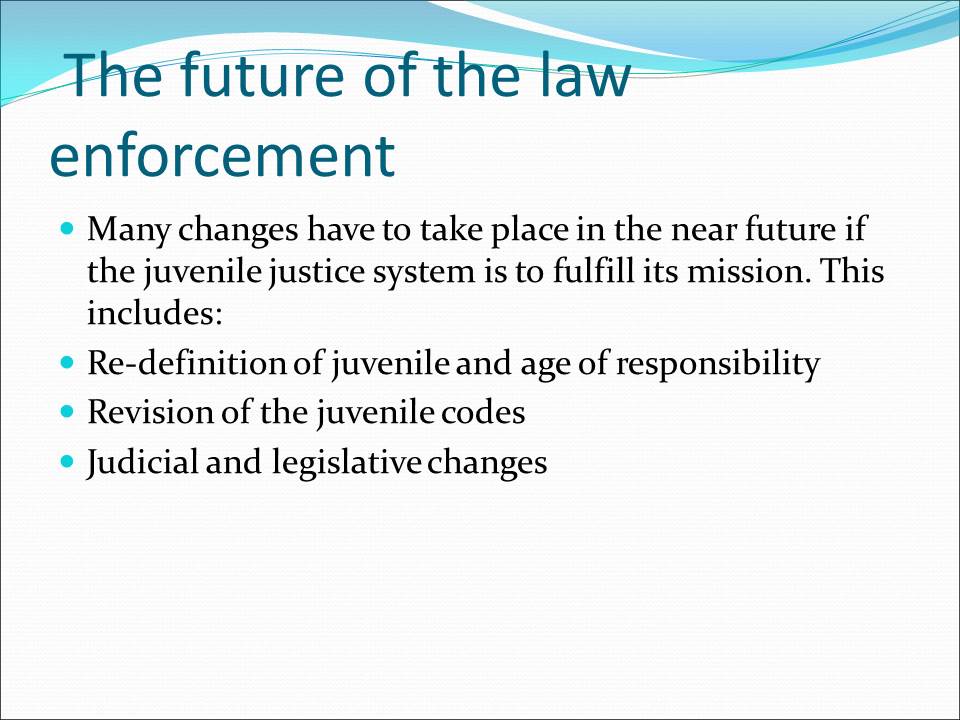
Recommendation for the courts
Lets first look at the problems facing the juvenile courts.
Social problems:
- Demographic forces.
- Teenage population has been decreasing in the recent past.
- Increased number of young people being processed in the juvenile courts.
- More court transfers and extended use if confinement and juvenile imprisonment.
First and foremost, demographic forces will change the perspective of juvenile justice. In the recent past, teenage population has been decreasing. For instance, between 1980 and 1990, the number of teenagers (aged 10-17 years) declined by about 11%. This was the resulting effect of the ‘baby bust’ decline in the U.S. birthrates that occurred in the late 1960s and 1970s (Siegel & Brandon, 2008 p246). Regardless of the smaller number of teenagers in the society, the fraction of young people processed through the juvenile court and the juvenile corrections system continued to rise. This raise was owed to more official and corrective juvenile justice policies that created more court transfers and extended use if confinement and juvenile imprisonment.

Economic problems
- Declining resources in child welfare system;
- Increased demand for institutional beds and out-of home placement;
- Decreasing social service budgets which decrease the juvenile court’s already scarce treatment resources.
Declining resources in the child welfare system have driven more upsetting adolescents to the juvenile justice system. The demand for institutional beds and out-of-home residency is mounting. A case in point is the large proportions of youths held in custody in a number of large California counties pending the accessibility of foster or group home beds. Because many juvenile justice clients and their families also are served by child welfare agencies, the dwindling social service budgets lessen the juvenile court’s already scanty treatment resources. These demographic, economical and fiscal forces mean that the juvenile justice system will handle many more intensely distressed adolescents in the next couple of years (Mortimer & Larson, 2002 p118).
- Overcrowding in the juvenile prisons;
- Out of date building;
- declining pool of experienced workers;
- Low salaries to workers as compared to other similar sectors;
- Limited training funds.
Juvenile correctional facilities are more and more filled to capacity. Over half of the youths in training schools live in constantly congested facilities. Due to the huge problems of prison and jail congestion faced by nearly all states, it is highly doubtful that juvenile corrections administrators will be able to effectively struggle for meager public revenues to erect new facilities. Furthermore, the nation’s experience with prisons and jails demonstrates that exclusive dependence on building new beds hardly ever solves congestion. Above and beyond problems with overloaded and out of date buildings, the juvenile justice system will face the pressing need to employ and train new personnel. The juvenile justice system, like most corporations will struggle for a declining pool of experienced workers in the subsequently two decades (Elrod & Ryder, 2009 p442). Salaries in the juvenile justice system conventionally have been lesser than similar salaries in the adult justice system and well below salaries in the profit private sector. Training funds are very limited for juvenile justice personnel. These trends signify very difficult times at the forefront for the already stressed juvenile justice system.

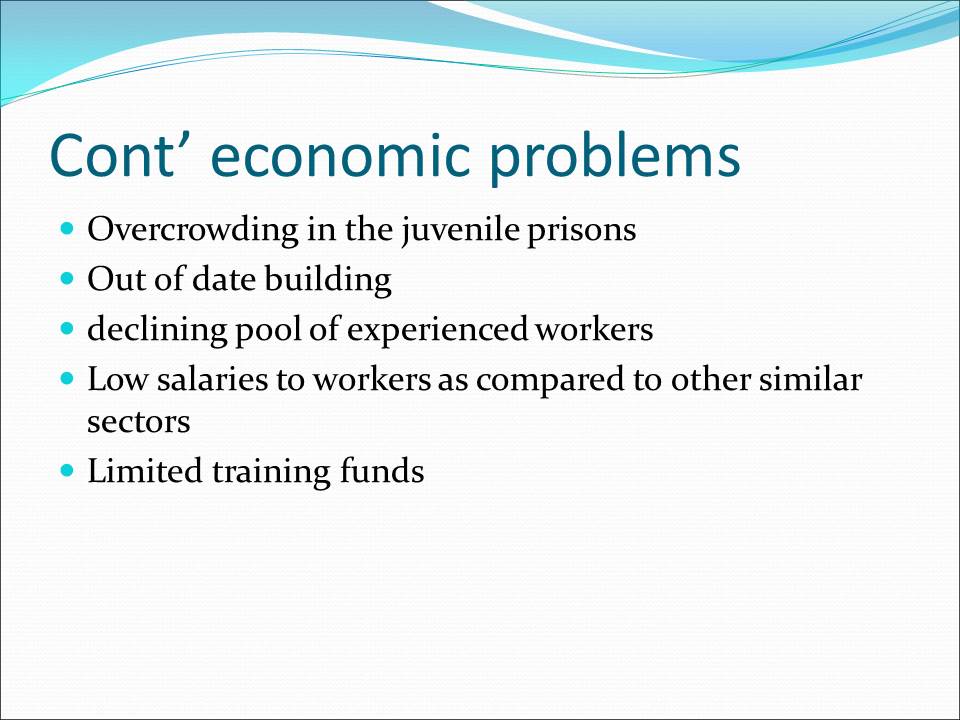
Abolition of the juvenile courts
- Many critics therefore argue for the abolition of the system and inclusion into the criminal court;
- This is to ensure that Juvenile offenders receive the same due process safeguards and constitutional rights as adults in criminal court;
- However they will receive a youth discount in consideration of their lower level of maturity and responsibility.
Many critics have therefore argued for the abolition of the juvenile court as we know it. A more formal criminal court hearing would ensure that juvenile offenders receive the same due process safeguards and constitutional rights as adults in criminal court. Juveniles would be treated differently only at the sentencing phase, when they would receive a “youth discount” in consideration of their lower level of maturity and responsibility. In addition to a youth discount in sentencing, Elrod & Ryder (2009 p12) recommends that youths who are sentenced to an institution be placed in separate correctional facilities for youthful offenders.
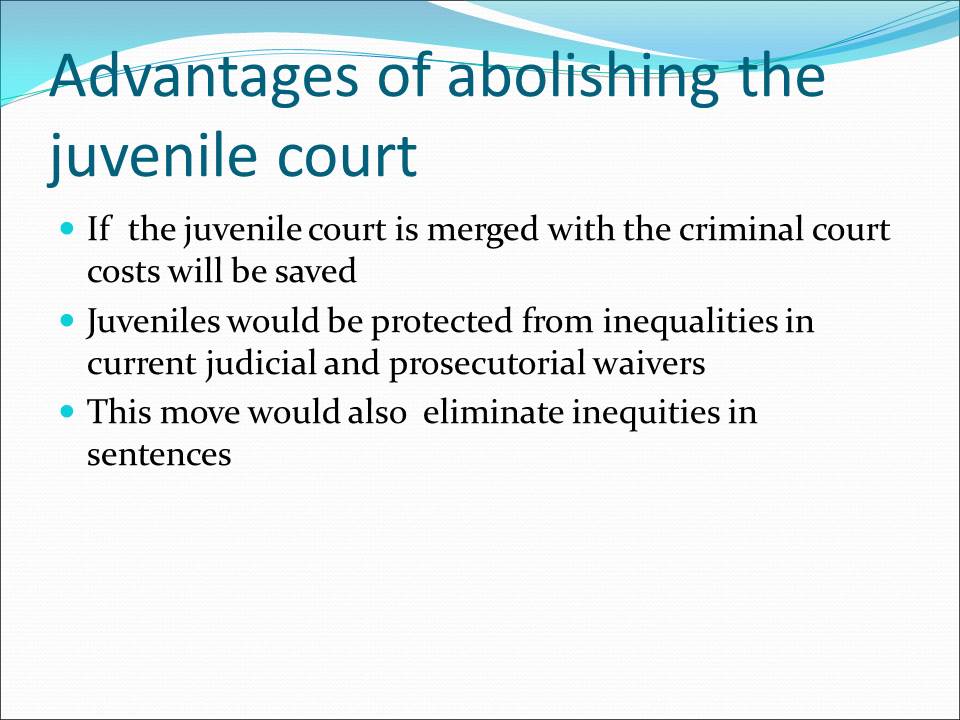
Recommendation for corrections
Critics of the Juvenile Justice System:
- Critics argue that the system provides neither justice nor therapy;
- It does not provide the same due process as the one provided in criminal courts;
- It is reluctant or incapable of protecting the due process rights of juveniles;
- It stand for a futile reaction to criminal behavior.
Many critics contend that the current juvenile court provides neither therapy nor justice and cannot be rehabilated. Critics of the juvenile courts sustain that the parents’ partial focus of the juvenile courts has led to court practices that refute juveniles the same due process protections given to adults, although the juvenile courts today function much like adults courts, and juveniles may face the same endorsement as adults (Elrod & Ryder, 2009 p442). Other critics of the juvenile courts assert that they stand for a futile reaction to criminal behavior, in particular serous of brutal delinquent behavior. According to these critics, the criminal courts are better equipped to deal with constant, serious, and cruel juvenile offenders.
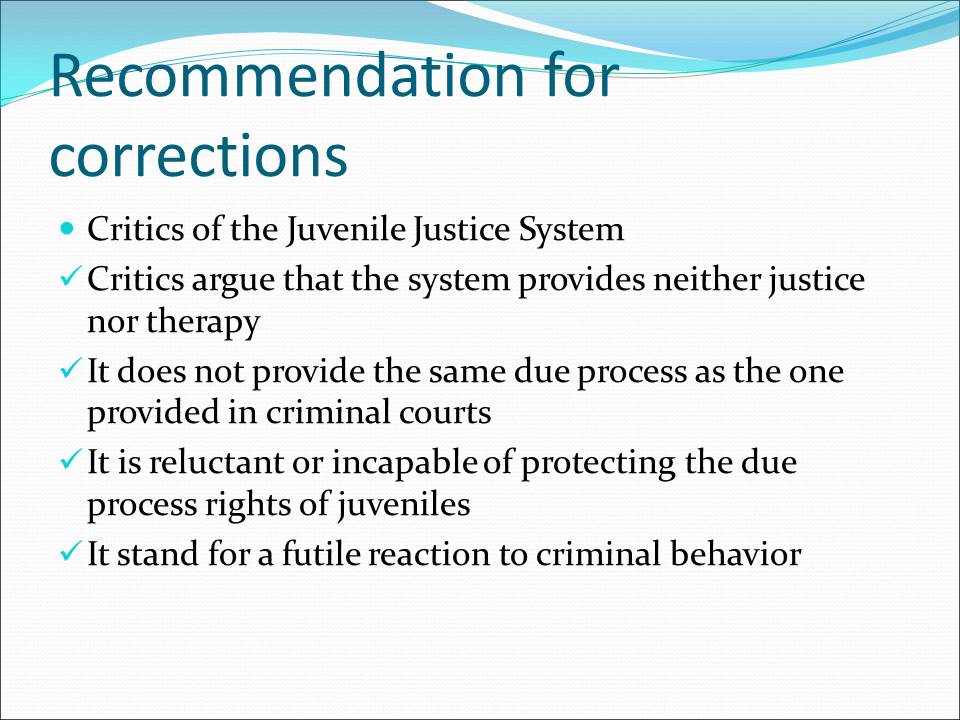
Advantages of abolishing the juvenile court
- If the juvenile court is merged with the criminal court costs will be saved;
- Juveniles would be protected from inequalities in current judicial and prosecutorial waivers;
- This move would also eliminate inequities in sentences.
Many critics argue that the juvenile court should be merged with the criminal court because according to them since the watershed of Supreme Court decisions of the 1960s, children’s courts closely paralleled the adult system. Such a practice would prevent inequalities in current judicial and prosecutorial waivers, which are decided upon by the subjective opinions of judges the lawyers who often treat minorities and minor property offenders unfairly, because all juvenile offenders would end up in criminal court (Edwards, 2008 p12). This would also eliminate the inequities in sentences, which can differ widely for the same offenses depending on whether a juvenile is tried in juvenile or criminal court.
- Juveniles would benefit from having the full legal process;
- They would enjoy due process rights;
- A right to an attorney and jury trial;
- The benefit of doubt for their inexperience through what is called a ”youth discount”.
Some people suggest that, states should abolish juvenile courts’ delinquency jurisdiction and formally recognize youthfulness as a mitigating factor in the sentencing of younger criminal offenders. In this way, juveniles would benefit from having the full legal process-including a right to an attorney and jury trial-while also getting the benefit of the doubt for their inexperience through what is called a ”youth discount”. In a “youth discount” juveniles would automatically get a certain percentage of time off of the mandated adult sentence, with the size of the percentage increasing the younger the offender is (Edwards, 2008 p20).
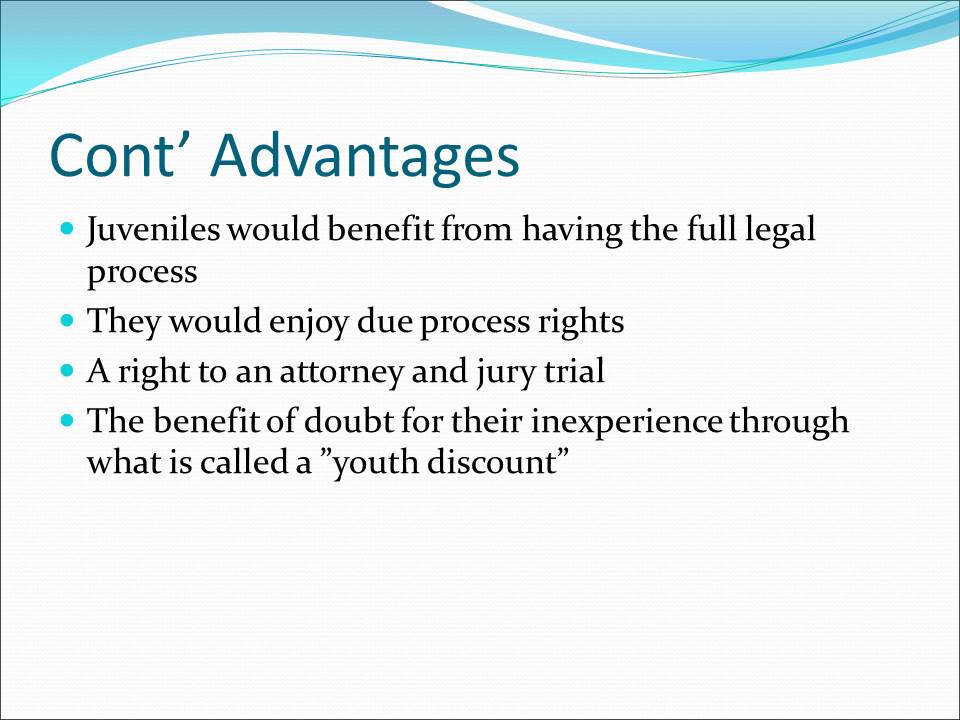

Weaknesses
- The lack of fit between adolescents and the criminal justice model;
- It is inefficient to prosecute adolescents in criminal courts, then adopt the principles of juvenile court;
- This idea contradicts the importance of several strategies adopted for adolescents during sentencing;
- It would limit the number and suitability of noncustodial options for adolescents.
The proposal to abolish the juvenile court appears to have some weaknesses. First, there seems to be a lack of fit between adolescents and a criminal justice model. Adolescents are a poor fit in the criminal court, and the juvenile justice model was introduced to improve this fit. Abolishing the juvenile court would make this lack of fit much worse and complicate the problem severely. It seems inefficient to prosecute adolescents in criminal court, and the adopt the principles of juvenile justice to prosecute these youth. The idea of abolishing the juvenile court contradict the importance that criminal court actors place on several strategies adopted for adolescents during sentencing (Siegel & Brandon, 2008 p519). If the juvenile court is abolished, the number and suitability of noncustodial options for adolescents would be limited.

Justification for the system
- Abolition of these courts is unlikely in the near future.
- However, changes have to be made in the current Juvenile justice System for it to fulfill its mission.
- Some experts support the present system and argue that, at times it follows the best interest of the juvenile.
- It also make constructive efforts to provide favorable interventions and programs.
Abolition of the juvenile court is implausible in the near future, but juvenile justice experts welcome the continuing reforms and concur that more changes are needed. Supporters of the current juvenile court admit that juveniles are given uneven and dual processing in court; not the same eminence of due process as adults, and for the purpose of both punishment and therapy. However, these supporters highlight that not everything about juvenile justice is unenthusiastic or unjust, particularly when juvenile courts do follow the best interests if the youthful lawbreaker and make constructive efforts to provide favorable interventions and programs aimed at delinquent change (Mortimer & Larson, 2002 p120).
Juvenile courts should not be abolished because:
- They provide a specialized venue for children and adolescents and their distinct needs;
- They focus on meeting the needs of offenders, fatalities, and the community at large;
- Provide a compassionate way of dealing with juvenile crime;
- Defend community wellbeing.
Juvenile courts are needed to provide a specialized venue for children and adolescents and their distinct needs, including a less threatening, less adult-oriented trial system. Because of its center of attention being to meet the needs of offenders, fatalities, and the community at large, the impartial approach to juvenile justice will possibly, provide an significant connection to more compassionate and dynamic ways of acting in response to juvenile crime while at the same time defending community wellbeing. One thing is for in no doubt, though: juvenile courts will go on with handling a diversity of problems presented by a varied and rising population of youths over the subsequently decade.

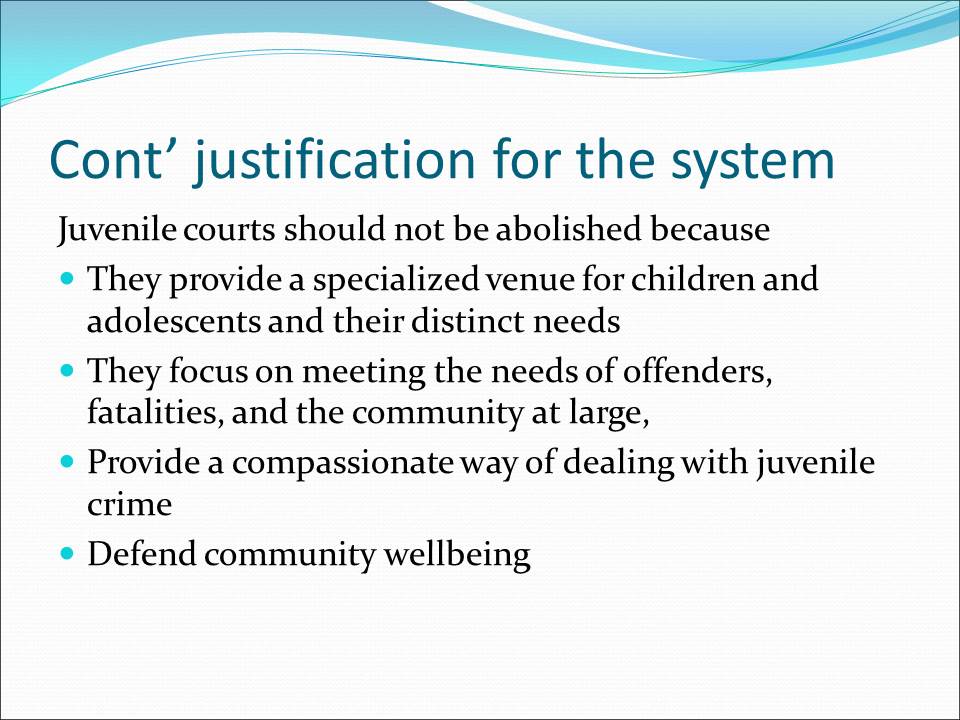
Funding
- Before the 1980s Juvenile justice system was financed from;
- State budget &;
- Local agencies;
- However, Youth Aids programs ware implemented in 1980-1981 to fund the juvenile courts.
Youth Aids to fund juvenile courts was implemented in 1981. Before the introduction of these Aids, juvenile courts were funded directly from the state budget. These services appeared to be free to the county agencies. In other counties, services to treat delinquent behavior were funded by local agencies which were quite expensive. The result of this was overcrowding of the juvenile prisons (Siegel & Brandon, 2008 p520). Government agencies had to look for other ways of financing these courts in order to reduce the cost to the state as well as solve the congestion problems. As a solution to solve these problems, Youth Aids programs were launched for treating delinquent and at-risk youth and financing juvenile correctional services.

Youth Aids allocation to counties
The table above shows the Youth Aids allocation to counties in year 2002. these funds are distributed according specific formulas represented the above categories.
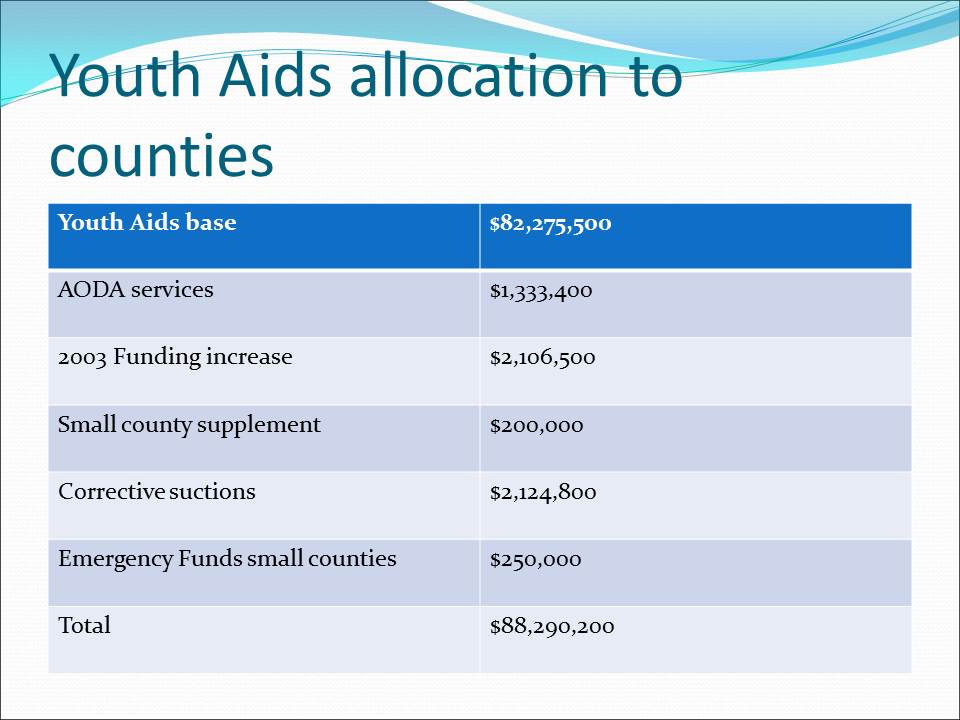
Conclusion
- New issues and challenges are expected to occur;
- Debates will continue on how to solve the present problems;
- Conditions of incarceration and issues of congestion are likely to persist in the near future.
The contemporary juvenile justice profile is expected to carry on through the near future. New issues and challenges are definite to arise. Present correctional troubles and anxieties will persist to be debated, and new theories will come out on how to resolve them. Conditions of incarceration are continuing issues so that congestion, management problems, and scoundrel officials will be expected be at the heart of episodic scandals in the future. Moreover, the problem of scheming effectual treatment options will be a constantly debated issue, almost certainly well into the far-away future; it is an issue that essentially requires constant deliberation. A vital question will be how to theoretically and in point of fact separate children in trouble from children in need.
- The present juvenile system will carry on in the near future;
- Discussion about the future of the juvenile justice system will continue in the distant future;
- It is unlikely that the Juvenile courts will be put to an end;
- What is likely is that the juvenile courts will be restructured.
The discussion over the future of juvenile justice will unquestionably persist for some time. Nevertheless, in the near future, it is improbable that the juvenile courts will be put an end to, and it is likewise doubtful that the criminal courts will be modernized according to the juvenile court model. What is likely is that, substantial energy will be bound for toward shielding the status quo, in some stations, and in others, the thrust will persist to restructure juvenile justice practice. Because juvenile courts are opinionated institutions, judges, being nominated officials in many cases, are time and again tentative to take risks or act in ways that can be supposed as soft on crime. Hence, juvenile courts, like other courts, tend to be rather conventional institutions that move towards change vigilantly. For most adolescents, the juvenile court seems to be the most appropriate forum for legal prosecution.
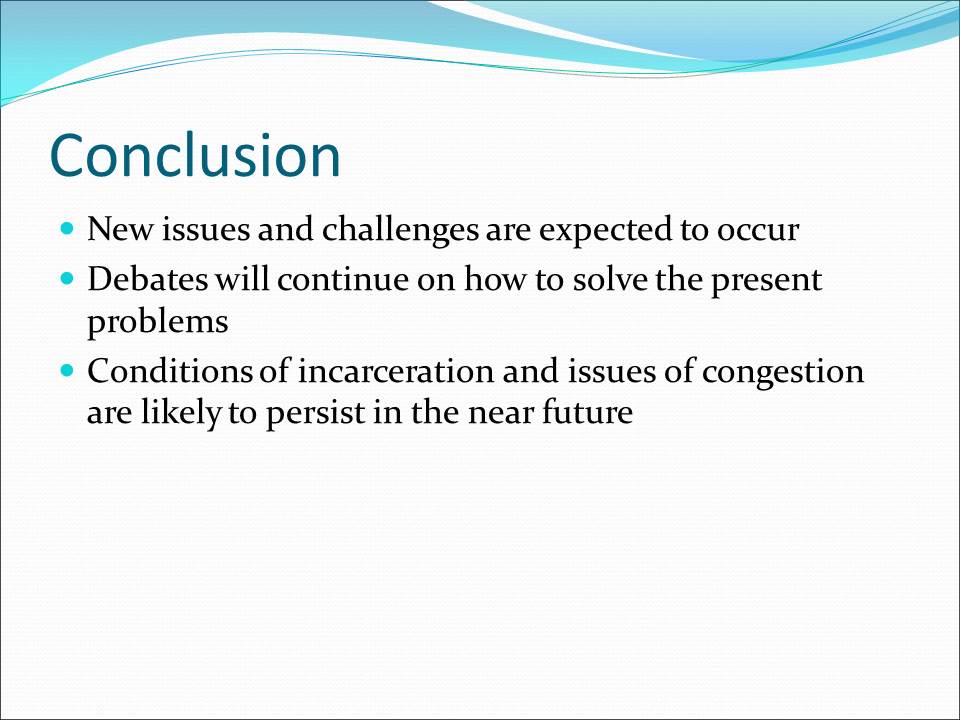
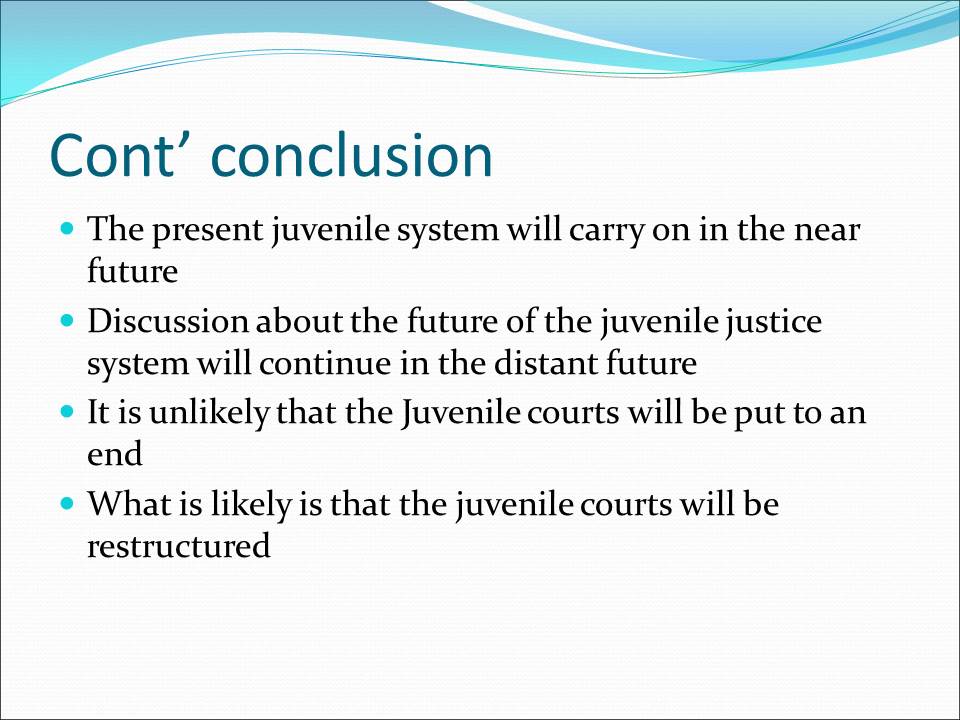
References
Edwards, J. M. (2008). Introduction to the juvenile justice system. New York: Lulu.com
Elrod, P. & Ryder S. R. (2009). Juvenile justice: a social, historical, and legal perspective. New York: Jones & Bartlett Learning
Hess, K. M. (2009). Juvenile Justice. London: Cengage learning
Juvenile Justice System. (2002). In World of Criminal Justice, Gale. Web.
Mortimer, J. T. & Larson, R. (2002). The changing adolescent experience: societal trends and the transition to adulthood. Cambridge University Press.
Siegel L. & Brandon C. W. (2008). Juvenile Delinquency: Theory, Practice, and Law. London: Cengage Learning.

